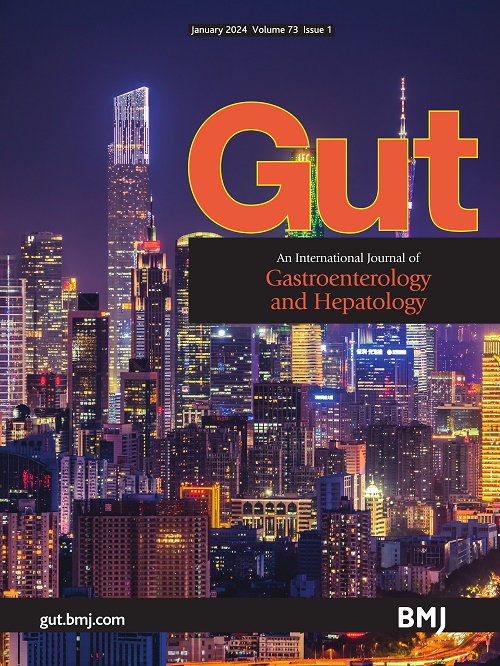351个携带者家族和超过37000个非携带者对照的临床和分子数据揭示了与种系CTNNA1功能丧失相关的遗传性弥漫性胃癌谱
IF 25.8
1区 医学
Q1 GASTROENTEROLOGY & HEPATOLOGY
引用次数: 0
摘要
背景:弥漫性胃癌(DGC)是种系CTNNA1变异携带者中最常见的表现,一项研究估计,到80岁时,其终生风险为49% -57%。关于ctnna1相关的遗传性弥漫性胃癌(HDGC)、功能丧失机制、变异型因果关系、疾病谱系和癌症风险的知识仍然很少。目的探讨CTNNA1基因型与表型的相关性,以改进携带者的基因检测标准、监测和降低风险建议。利用来自351个ctnna1变异携带者家族和37428个来自欧美的非携带者家族的1308名个体的分子、临床和群体数据,我们利用多变量logistic回归分析了基因型-表型的相关性。利用CRISPR/Cas9敲除ctnna1的胃癌细胞和ctnna1人源化的果蝇,我们评估了ctnna1相关的功能丧失机制。结果sctnna1截断转录本被无义介导的mRNA衰变(NMD)降解,种系ctnna1截断载体的DGCs丢失αE-catenin。与非截断转录本相比,这些转录本在果蝇中是无功能的。与非截断型携带者相比,截断型携带者的DGC风险高8倍。ctnna1截断变异携带者发生胃癌和小叶性乳腺癌(LBC)的风险分别比CDH1致病性/可能致病性变异携带者低5倍和8倍。与野生型个体相比,ctnna1截断变异携带者的GC风险高7倍,cdh1截断变异携带者的GC风险高38倍。LBC在ctnna1截断的携带者中复发,一些缺乏HDGC标准。简化了之前CTNNA1基因检测的标准,产生了“波尔图”标准,与HDGC 2020临床指南相比,该标准将CTNNA1携带者家族的检出率提高了9%,没有性能损失。黄斑营养不良模式-2与非截断型变异呈正相关,特别是α e -连环蛋白m片段。结论CTNNA1截断变异与DGC和LBC呈正相关,NMD是导致CTNNA1下调的病理生理机制。我们证明,与CDH1相比,CTNNA1是一个中等外显率的HDGC基因。这一新知识对于确定ctnna1携带者个人和家庭的监测和/或预防措施至关重要。本文章由计算机程序翻译,如有差异,请以英文原文为准。
Hereditary diffuse gastric cancer spectrum associated with germline CTNNA1 loss of function revealed by clinical and molecular data from 351 carrier families and over 37 000 non-carrier controls.
BACKGROUND
Diffuse gastric cancer (DGC) is the most common manifestation in germline CTNNA1 variant carriers, with one study estimating a 49-57% lifetime risk by age 80. Knowledge on CTNNA1-associated hereditary diffuse gastric cancer (HDGC), loss-of-function mechanisms, variant-type causality, disease spectrum and cancer risks remains scarce.
OBJECTIVE
Explore CTNNA1 genotype-phenotype associations to improve genetic testing criteria, surveillance and risk-reduction recommendations for carriers.
DESIGN
Using molecular, clinical and population data from 1308 individuals from 351 CTNNA1-variant carrier families and 37 428 non-carriers from European and American ancestries, we analysed genotype-phenotype associations with multivariable logistic regression. With CRISPR/Cas9 CTNNA1-knockout gastric cancer (GC) cells and CTNNA1-humanised Drosophila, we assessed CTNNA1-associated loss-of-function mechanisms.
RESULTS
CTNNA1-truncating transcripts are degraded by nonsense-mediated mRNA decay (NMD), and DGCs from germline CTNNA1-truncating carriers lose αE-catenin. These transcripts are non-functional in Drosophila, in contrast to non-truncating transcripts. DGC risk is eightfold higher in truncating, compared with non-truncating carriers. The risk of GC and lobular breast cancer (LBC) development in CTNNA1-truncating variant carriers is fivefold and eightfold lower than in CDH1 pathogenic/likely pathogenic variant carriers, respectively. Compared with wild-type individuals, GC risk is 7-fold higher in CTNNA1-truncating and 38-fold higher in CDH1-truncating variant carriers. LBC is recurrent among CTNNA1-truncating carriers, some lacking HDGC criteria. Simplification of previous criteria for CTNNA1 genetic testing produced the 'Porto' criteria, which increased CTNNA1-carrier families' pick-up rate by 9%, without performance loss compared with the HDGC 2020 clinical guidelines. Macular dystrophy patterned-2 was positively associated with non-truncating variants, specifically in the αE-catenin M-fragment.
CONCLUSION
We provide compelling evidence supporting that CTNNA1-truncating variants positively associate with DGC and LBC, and NMD as the pathophysiological mechanism leading to CTNNA1 downregulation. We demonstrate that compared with CDH1, CTNNA1 is a moderate penetrance HDGC gene. This new knowledge is essential to define surveillance and/or prophylactic measures for CTNNA1-carrier individuals and families.
求助全文
通过发布文献求助,成功后即可免费获取论文全文。
去求助
来源期刊

Gut
医学-胃肠肝病学
CiteScore
45.70
自引率
2.40%
发文量
284
审稿时长
1.5 months
期刊介绍:
Gut is a renowned international journal specializing in gastroenterology and hepatology, known for its high-quality clinical research covering the alimentary tract, liver, biliary tree, and pancreas. It offers authoritative and current coverage across all aspects of gastroenterology and hepatology, featuring articles on emerging disease mechanisms and innovative diagnostic and therapeutic approaches authored by leading experts.
As the flagship journal of BMJ's gastroenterology portfolio, Gut is accompanied by two companion journals: Frontline Gastroenterology, focusing on education and practice-oriented papers, and BMJ Open Gastroenterology for open access original research.
 求助内容:
求助内容: 应助结果提醒方式:
应助结果提醒方式:


